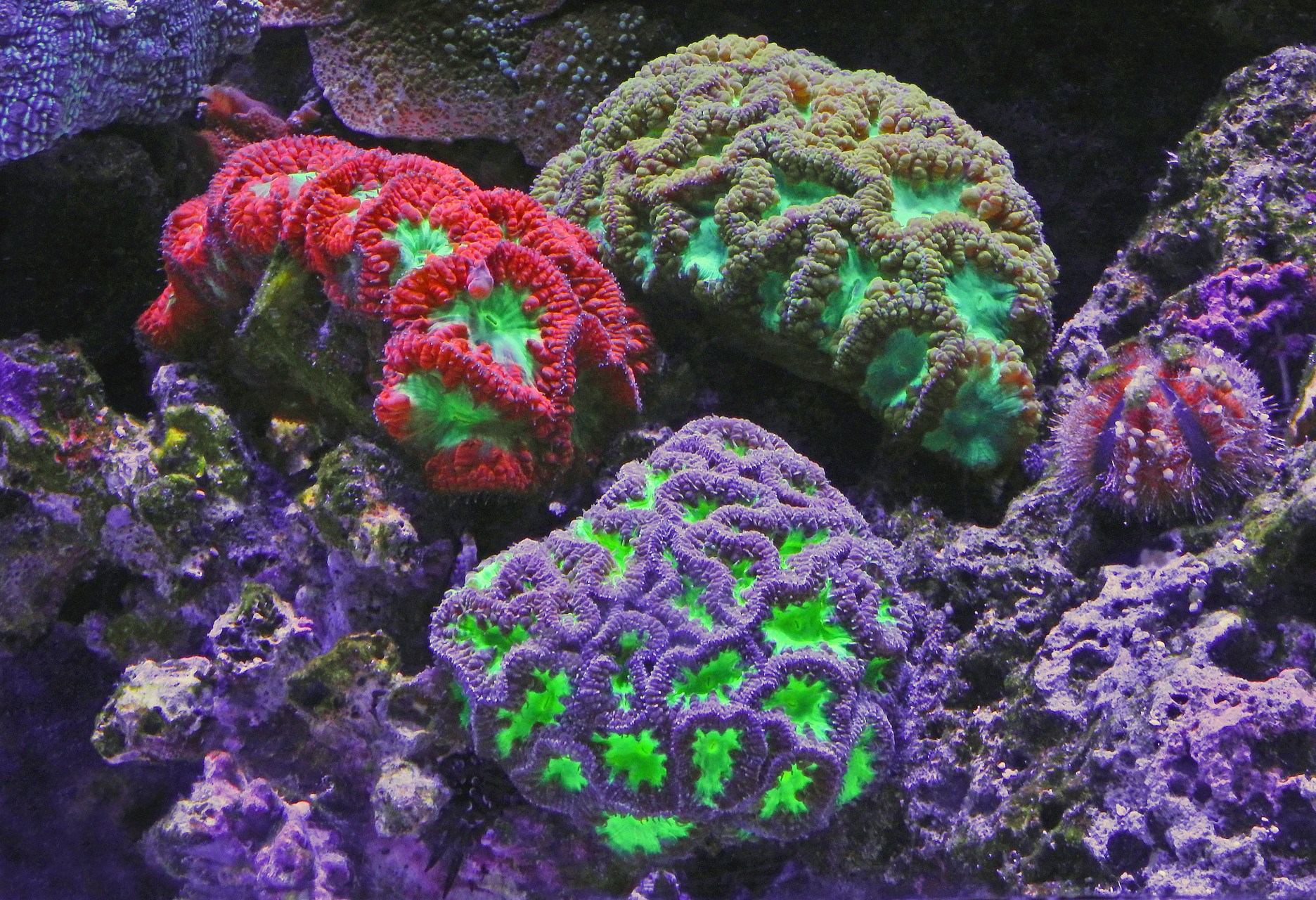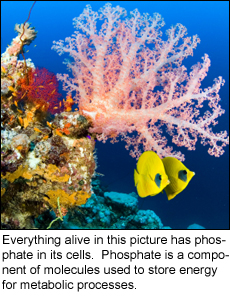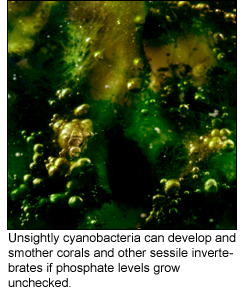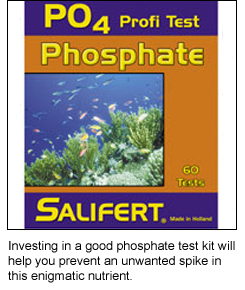Revisited: Chemistry Corner - PHOSPHATE


In marine husbandry, there are so many chemical factors that contribute to our successes and failures as marine aquarists, it can be difficult to get our heads around exactly what we need to know. Obviously, there are good chemicals and bad chemicals. But is it really all that black and white? In fact, it usually is not! In general biology, there are plenty of examples of chemicals which must exist within precise ranges, or they risk becoming problematic. A brief example of this issue comes from oxygen, which we must have to breathe. However, if oxygen is too prevalent, its power of oxidative corrosion can cause many health issues in the breather. For marine systems, the desired ranges of many chemicals are similarly restrictive. In this installment of Chemistry Corner, we explore a chemical we usually strive to eliminate, though it must be present in some quantity to fulfill the needs of a functioning bio-filter. The chemical to which I am referring is phosphate, and it may surprise many readers to find out that phosphate plays a role in reducing the amount of waste nutrients in tank water. At the same time, phosphate input, and overall levels, must be tightly controlled in order to ensure that the there are no proliferations of unwanted algae and cyanobacteria. To be sure, phosphate is a wholly necessary evil.
In case you are wondering if I am going to tell you that you have misunderstood phosphate for all this time and that it does not need to test at zero, do not worry, I will not. This article points out that though testing should produce undetectable levels, the reality is far more complex than that. There is phosphate present in a marine aquarium at all times. It simply gets used up so fast in a properly balanced tank that its concentration in the water never comes remotely close to what is readable by a store-bought test kit. This is how it should be, at least, and the fate of your aquarium relies upon it. If you are registering phosphates when you test, you have a problem! Yet, do not discount the importance of phosphate to your livestock, as we shall soon see.
So what is the real deal regarding phosphate? The answer is that phosphate, which is an ion comprised of phosphorous and oxygen, is part of all cells. Phosphate is a key component of the chemicals cells use to store energy, specifically adenosine triphosphate (ATP), nicotinamide adenine dinucleotide (NAD+), and nicotinamide adenine dinucleotide phosphate-oxidase (NADPH). It is also a necessary component of photosynthesis. In fact, without phosphate there would be no photosynthesis at all. Therefore, corals, clams, algae, and other photosynthetic organisms would have to derive nutrition from other sources (a task most are ill-equipped to carry out). Phosphate is a critical part of the precursor to glucose, glyceraldehyde 3-phosphate, as well. In short, without phosphate there would be no food or energy created from light absorption.
The primary relevance of phosphates role, as it pertains to marine husbandry, is that which it plays during photosynthesis. To the marine aquarist, the implication for corals and clams is obvious. On the other hand, the conception about algae often takes a negative connotation, especially where algal and cyanobacterial blooms are unsightly, harmful, and a tell-tale sign of system-wide problems. To the contrary, some types of algae are highly beneficial, such as the macroalgae used in refugia, and the microalgae that live in the top few inches of sandbeds. Though elevated phosphate levels undoubtedly contribute to undesired growth of cyanobacteria, filamentous algae, and diatoms, the proliferation of such organisms is indicative of a larger husbandry issue. In addition,

You might ask how this all fits together. In short, there is no short answer! There are cycles within cycles, and at each step of the way, phosphate is both released and sequestered. The well-balanced aquarium has phosphate exchanges flowing back and forth at equal rates. This balance is called equilibrium, and is essential for maintaining optimal water conditions. When out of balance, unwanted algae and cyanobacteria can begin to grow unchecked.
There are two primary sources of phosphate input in marine aquaria. The first is food, which unavoidably contains significant levels of the chemical. The second input is tap water, especially in agricultural areas using fertilizers that seep into local water tables. Fortunately, the availability of relatively inexpensive RO/DI filters has eliminated this problem for many aquarists. Phosphate is also recycled within the aquarium system, either when it is released in urine and feces, or during the decomposition of a dead animal. A third potential input comes from cheap activated carbon, which can release phosphate into the water as it absorbs other pollutants.
Examining the phosphate cycle more closely shows that the entire thing is controlled by food. Food is added and subsequently broken down into its constituent parts, one of which is phosphate. As the food is eaten, only about 10% is added to the body mass of the consumer. A little bit more is used for metabolic processes, and the rest is expelled as waste. From there, the waste is consumed by other organisms again and again, while the same relative percentage is used with each subsequent pass through the cycle. In sand beds and in the pores of live rock, bacteria and microalgae absorb phosphate and other nutrients directly, and use it for their own metabolic processes (including photosynthesis). In turn, these organisms are eaten by benthic infauna, digested, and some phosphate is re-released. Interestingly, a thriving infauna population can spawn prolifically and provide a significant source of planktonic food for corals, clams, and other filter feeders. Obviously, each step of the cycle permanently uses up a little bit of phosphate at a time, until it is all consumed or more food is added. Though the complexity of the cycle(s) makes it seem like it might be difficult for tank inhabitants to expend all the phosphate, just the opposite is true. A large population of microorganisms can rapidly deplete a closed system of its phosphate, leaving levels dangerously low. At the same time, excess additions of phosphate via food will have contributed to excess cellular growth in undesired algae and bacteria. For this reason, food addition must be a tightly controlled event.
With no phosphate input, the chemical would slowly become sequestered in cells, and metabolic processes like photosynthesis would halt. Photosynthetic corals would starve to death, die and decompose, and fuel the beginning of another short-lived phosphate cycle. However, this cycle would be punctuated by a large phosphate spike, followed by significant bacterial and algal blooms. Once again, when the phosphate became depleted, organisms would die. This time however, it would be the bacteria and algae dying in large numbers. Their cells would be consumed by aerobic bacteria, which would also act to strip the water column of oxygen. A once thriving tank would suddenly become anoxic, and inappropriate for most forms of life.
The cycle describe in the preceeding paragraph is actually a microcosmic view of the effects of pollution on the oceans. When large amounts of fertilizers are flushed into rivers from areas of agriculture, the nitrogenous and phosphate-laden nutrients make their way to the sea. There, the nutrients are rapidly consumed by planktonic algae, creating a bloom. The bloom dies almost as quickly as it was born, and kicks off a downward cycle of anoxia that leads to a so-called dead-zone. Perhaps the most textbook case of a dead-zone occurs in the Gulf of Mexico, where the Mississippi River carries massive quantities of agricultural run-off to the Gulf Coast. Here, the dead-zone can extend for thousands of square miles, killing any oxygen consuming organisms in its path.

In a closed system, there are two ways to effectively control phosphate levels. The first is easy and intuitive: do not feed too much. The old adage about adding only what will be eaten in two to three minutes is as true as it is clich. However, the saying also implies that uneaten food should never be left in the tank to rot. Use a net or a siphon tube and get it out of there! You may still want to feed twice daily, if you have fish, but most invertebrates only need food a few times each week. The second way to effectively control phosphate is through the use of macroalgae in a refugium tank. Algae such as Halimeda, Gracillaria, Enteromorpha, and Chaetomorpha spp. all make excellent nutrient exporters that can compete well with diatoms and cyanobacteria for dissolved phosphate. Be sure to regularly harvest some of the macroalgae though, as it will multiply fast and begin to over-consume nutrients relative to your feeding regime. Finally, a good clean-up crew with plenty of herbivorous grazers will take care of any unsightly blooms before they become a problem. In the event of a dangerous spike in phosphate, phosphate absorbing pads can be used. However, there should be no need to use these pads on a regular basis in a well-balanced system. Moreover, if a spike leads to an increase in bacterial and algal populations, the sudden removal of the offending chemical can lead to a dangerous die-off.
In a funny way, phosphate is as deadly as it is divine. By that, I mean that phosphate is an enormous part of life on Earth. It ensures that photosynthesis, the primary energy source for life on Earth, is carried out dutifully. It also holds together the powerhouse molecules all cells use. At the same time, unchecked phosphate input can cause massive die-offs in marine organisms. It walks a very fine line between the needed and the unwanted. Indeed, in a very real sense, phosphate is a necessary evil.
Works Cited:
Lardizabal, S. Beyond the Refugium a Macroalgae Primer. Reefkeeping Online Magazine, Jan. 2001. URL: < http://reefkeeping.com/issues/2007-01/sl/index.ph... >
Shimek, R.L. Dearest Mudder.... The Importance of Deep Sand. Aquarium Fish Magazine, Mar. 2001. Revised 2006. URL: < http://www.ronshimek.com/deep_sand_beds.html >
Shimek, R.L. How Sand Beds Really Work. Reefkeeping Online Magazine, June 2003. URL: < http://reefkeeping.com/issues/2003-06/rs/feature/... >
Tullock, J.H. Water Chemistry for the Marine Aquarium. Barrons: Hauppauge. 2002.